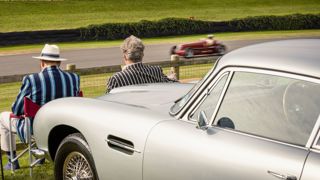The British motor industry’s halcyon days | Axon’s Automotive Anorak
Adrian Hallmark – Aston Martin’s experienced and accomplished new CEO – recently announced that the prestigious English luxury sports car maker is immediately cutting its production forecast by one thousand units against its original 2024 production target, due to a combination of component supply disruptions and reduced demand for its products in the all-important Chinese market. Hallmark’s announcement instantly caused a 25 per cent fall in the company’s share price, which was already running at 95 per cent below its 2018 flotation level.
This unwelcome but realistic news contrasts with Aston Martin’s position 60 years ago when in 1964, the still small Newport Pagnell firm was poised for unprecedented international recognition and success, as it was about to struggle to keep up with global demand as it introduced its new DB5 model.

The sensuous new DB5 dramatically made its world debut 60 years ago on the big screen as the remarkable gadget-laden automotive star (alongside Sean Connery) in the latest James Bond film, Goldfinger – the world’s highest grossing movie of 1964.
This global desire and admiration for the new Aston Martin typified the huge world-beating success that the British automotive industry was enjoying at the time. Great Britain was on a high, with the country’s car factories producing excellent and accomplished motor vehicles.
Alongside the DB5, from the BMC’s Mini (especially the sporting new Cooper variants), advanced Austin/Morris 1100 and the Jaguar E-Type, to the aspirational Triumph 2000, the lively Ford Lotus Cortina, and technically clever Rover 2000 (the very first car to be voted the European Car of the Year), the whole planet seemingly wanting to drive a British car.

The UK also led the way in motor racing in 1964, with the giant-killing Mini Cooper taking its first of three (but should have been four!) Monte Carlo Rallye victories with Paddy Hopkirk at the wheel. Grand Prix racing was dominated by British teams such as Lotus, Brabham and BRM taking the chequered flag at seven of the that season’s ten Formula 1 races, with future F1 champions like Jim Clarke and Graham Hill at the wheel.
Hill was also one of the all-British driving team to bring the jet-powered William Towns-designed Rover-BRM home for a pioneering ‘experimental’ class win at the 1964 Le Mans 24 Hours race. Similar gas turbine technology also helped Brit Donald Campbell to become the fastest man on Earth in 1964 when he took his speed record-breaking Bluebird CN7 up to 403mph.
Despite the success and hugely welcome economic contribution the British vehicle industry was making 60 years ago, ultimately it was Harold Wilson’s government that helped to destroy the UK’s mass motor industry. They did this by the forced merger of the once mighty BMC and Leyland vehicle groups, which in the mid-1960s had a combined UK new vehicle market share approaching 70 per cent.
This short-sighted Labour merger created the cumbersome and unmanageable British Leyland in 1968, swallowing some once proud British makes such as Jaguar, Austin, Morris, Rover, Triumph, Mini and MG plus many more. The scale of British Leyland and its various later incarnations, ultimately led to the collapse of the MG Rover combine in 2005 and thus, the demise of the mainstream mass-production British motor industry, with Ford pulling out of its famous Dagenham plant a few years earlier.

Of the remaining ex-British Leyland offshoots, only Mini, Jaguar and Rover’s old Land Rover off-shoot still survive today. The British factories for Japanese automotive giants Nissan and Toyota still do well today at churning out strong-selling models, though Japan’s Honda closed down its Swindon plant a few years back.
Jaguar’s decision a few months ago to virtually halt all UK production of its entire model range is a concern as the world waits patiently for its new electric Jaguar models. Production at Jaguar’s Land Rover sibling thankfully remains strong however, but the future of Vauxhall Astra production at Stellantis’ Ellesmere Port plant, as well as its light commercial vehicle manufacturing at its Luton facility, could be in future jeopardy based on concerning Stellantis comments about the future viability of its British manufacturing plants.
On a brighter note, Britain leads the world of motorsport, with the majority of the F1 teams and expertise based here, for example. Global demand for the products of Land Rover, Mini, Lotus, Rolls-Royce and Bentley thankfully remains buoyant, too and this demand helps to keep UK production facilities active, although unlike 60 years ago, each of these very British automotive brands are now owned by overseas companies.
Although no longer the major mainstream automotive player that it was 60 years ago, the future for Britain’s motoring scene still looks encouraging, with the country leading the luxury scene through exclusive low-volume production firms such as Rolls-Royce, Land Rover, Aston Martin, McLaren and Bentley. Just don’t expect to see a return to the mass-market volume production models of a type that dominated the British new car market back in 1964.
Ford Dagenham image courtesy of Getty Images.
road
news
Axon's Automotive Anorak
-

GRRC Ultimate Access Package
-

GRRC Lavant Bank Parking
-

The Gordon Pavilion
-

GRRC Ultimate Access Package






